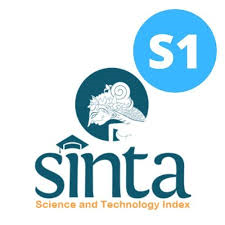COMPARATIVE LEAF ANATOMY AND MICROMORPHOLOGY OF ASYSTASIA GANGETICA T.ANDERSON SUBSP. MICRANTHA (NEES) ENSERMU AND RHINACANTHUS NASUTUS (L.) KURZ (JUSTICIINAE, ACANTHACEAE) FROM PENINSULAR MALAYSIA
Abstract
Acanthaceae family has been used traditionally for medicinal purposes, especially amongst the native communities in Peninsular Malaysia. Nowadays, many taxonomists have difficulties in the identification of the Acanthaceae species due to its morphological similarities and when there is an incomplete part of plants obtained from the field sampling. But until now, there is no comprehensive study that has been documented especially on the Acanthaceae family, specifically for A. gangetica subsp. micrantha and R. nasutus. To avoid incorrect species identification, a systematic study that involved the leaf anatomy and micromorphology parts is being used for the identification and classification of plants in the Acanthaceae. Therefore, the main objective of this present study is to identify the leaf anatomical and micromorphological characteristics that can be used in plant identification and for supportive data in plant classification. The leaf anatomical and micromorphological studies that are conducted on species studied involve several procedures such as cross-section using a sliding microtome, and observation under a light microscope and scanning electron microscope. The anatomical and micromorphological characteristics observed that have been used to identify each species studied include patterns of petiole and midrib vascular bundles, leaf margin, leaf lamina, presence of cuticular striae, and the presence of trichomes. The results of this study showed that the cystolith cells can be found only in midrib of A. gangetica subsp. micrantha while it also recorded in petiole, midrib, and the leaf lamina of R. nasutus. Observation under the light microscope revealed nine types of trichomes in R. nasutus meanwhile seven trichomes were recorded in A. gangetica subsp. micrantha. Other than that, the present of cuticular striae only recorded at the abaxial epidermis of A. gangetica subsp. micrantha. In conclusion, results showed that anatomical and micromorphological characteristics have taxonomic significance that can be used in the identification and classification, especially at the species level
Keywords
Full Text:
PDFReferences
AMIRUL-AIMAN, A. J., NORAINI, T., NURUL-AINI, C. A. C. & RUZI, A. 2014. Trichomes morphology on petals of some Acanthaceae
species. Reinwardtia, 14(1): 79‒83.
AMRI, C. N. C. A., TAJUDIN, N. S., SHAHARI, R., AZMI, F. M., TALIP, N. & MOHAMAD, A. L. 2018. Comparative leaf anatomy of selected medicinal plants in Acanthaceae. The International Medical Journal 17 (spec issue 2): 17‒23.
AMRI, C. N. C. A., TALIP, N., MOHAMAD, A. L., CHUNG, R. C. K., NURHANIM, M. N. & RUZI, A. R. 2013. Systematic significance of
petiole anatomical characteristics in Microcos L. (Malvaceae: Gresswioideae). Malayan Nature Journal 65(2&3): 145‒170.
AMRI, C. N. C. A., TALIP, N., MOHAMAD, A. L., JUHARI, M. A. A. A., RUZI, A. R. & IDRIS, S. 2014. Taxonomic significance of leaf micromorphology in some selected taxa of Acanthaceae (Peninsular Malaysia). AIP Conference Proceedings. Universiti Kebangsaan Malaysia, Selangor.
BARTHLOTT, W. 1981. Epidermal and seed surface characters of plants: systematic applicability and some evolutionary aspects. Nordic Journal of Botany 1(3): 345–354.
BARTHLOTT, W. 1990. Scanning electron microscopy of the epidermal surface in plants.
In CLAUGHER, D. (Ed.). Scanning Electron Microscopy in Taxonomy and Functional Morphology. Clarendon Press Oxford. Pp. 69–94.
BARTHLOTT, W., NEINHUIS, C., CUTLER, D., DITSCH, F., MEUSEL, I., THEISEN, I. & WILHELMI, H. 1998. Classification and
terminology of plant epicuticular waxes. Botanical Journal of the Linnean Society 126 (3): 237‒260.
BAAS, P. & GREGORY, M. 1985. A survey of oil cell in the dicotyledons with comments on their replacement by and joint occurrence with mucilage cell. Israel Journal Botany 34: 167‒186.
BORG, A. J., McDADE, L. A. & SCÖNENBERGER 2008. Molecular phylogenetics and morphological evolution of Thunbergioideae (Acanthaceae). Taxon 57(3): 811‒822.
GOPAL, T. K., MEGHAL, G., CHAMUNDEESWARI, C. & REDDY, C. U. 2013. Phytochemical and pharmacological studies on whole
plant of Asystasia gangetica. Indian Journal of Research in Pharmacy and Biotechnology 1(3): 365‒370.
HAMID, A. A., AIYELAAGBE, O. O. AHMED, R. N., USMAN, L. A. & ADEBAYO, S. A. 2011. Preliminary phytochemistry, antibacterial and antifungal properties of extracts of Asystasia gangetica Linn T.Anderson grown in Nigeria. Advances in Applied Science
Research 2(3): 219‒226.
HARE, C. L. 1942. On the taxonomic value of the anatomical structure of the vegetative organs of the dicotyledons: the anatomy of the petiole and its taxonomic value. Proceedings of the
Linnean Society of London 555(3): 223‒229.
HSU, T. W. & CHIANG, T. Y. 2005. Asystasia gangetica (L.) T. Anderson subsp. micrantha(Nees) Ensermu (Acanthaceae), a newly naturalized plant in Taiwan. Taiwania 50(2): 117‒122.
HU, C. C., DENG, Y. F., WOOD, J. R. I. & DANIEL, T. F. 2011. Acanthaceae. In: WU, Z. Y., RAVEN, P. & HONG, D. Y. (Eds.). Flora
of China. Vol. 19. Missouri Botanical Garden Press, St. Louis. Pp. 369‒477.
INAMDAR, J. A. 1970. Epidermal structure and ontogeny of caryophyllaceous stomata in some Acanthaceae. Botanical Gazette 131(4): 261‒268.
JOHANSEN, D. A. 1940. Plant Microtechnique. McGraw-Hill Book Co, Inc, New York and London.
JUHARI, M. A. A. A., NORAINI, T., AMRI, C. N. A. C. & RAHMAN, M. R. A. 2014. Trichomes morphology in flower petal of Acanthaceae species. Reinwardtia 14(1): 79‒83.
KENG, H. 2003. Orders and Families of Malayan Seed Plants. Singapore University Press, Singapore.
KUPRADINUN, P., SIRIPONG, P., CHANPAI, R., PIYAVIRIYAGUL, S., RUNGISIPIPAT, A. & WANGNAITHAM, S. 2009. Effects of
Rhinacanthus nasutus Kurz on colon carcinogenesis in mice. Asian Pacific Journal of Cancer Prevention 10(1): 103‒106.
LEROUX, O. 2012. Collenchyma: a versatile mechanical tissue with dynamic cell walls. Annals of Botany 110(6): 1083–1098.
LEVIN, F. A. 1929. The taxonomic value of veinislet areas based upon a study of the genera Barosma, Cassia, Erythroxylon and Digitalis. Journal of Pharmacy and Pharmacology 2: 17‒43.
MANZITTO-TRIPP, E. A., DARBYSHIRE, E., DANIEL, T. F., KIEL, C. A. & MCDADE, L. A. 2021. Revised classification of Acanthaceae and worldwide dichotomous keys. Taxon 71(1): 103‒153.
MC DADE, L. A., DANIEL, T. F. & KIEL, C. A. 2008. Toward a comprehensive understanding of phylogenetic relationships among lineages of Acanthaceae S.L. (Lamiales). American Journal of Botany 95(9): 1136‒1152.
METCALFE, C. R. & CHALK, L. 1965. Anatomy of the Dicotyledons Volume 1. The Clarendon Press, Oxford.
METCALFE, C. R. & CHALK, L. 1979. Anatomy of the Dicotyledons Volume 1. The Clarendon Press, Oxford.
MUNAVVAR, A. S., ABDULLAH, N. A., ABDUL, H. K. & NOOR, A. M. 2004. Evaluation of anti-fungal and anti-bacterial activity of a
local plant Rhinacanthus nasutus (L.). Journal of Biological Sciences 4(4): 498‒500.
NURHANIM, M. N., TALIP, N., CHUNG, R. C. K., AMRI, C. N. C. A. & RUZI, A. R. 2014. Nilai taksonomi ciri anatomi daun genus
Schoutenia Korth. (Malvaceae subfam. Brownlowioideae). Sains Malaysiana 43(3): 331‒338.
O’NEILL, C. S. 2010. Anatomy of the shrimp plant, Justicia brandegeana (Acanthaceae). Studies by Undergraduate Researchers at Guelph 3(2): 41‒47.
PATIL, A. M. & PATIL, D. A. 2011. Occurrence and significance of cystoliths in Acanthaceae. Current Botany 2(4): 1‒5.
RASHID, Z. S. A., AMRI, C. N. A. C. & SHAHARI, R. 2020. Leaf anatomy of the medicinal plant Sphagneticola trilobata (L.) Pruski. Journal of Sustainability Science and Management17 (3): 112‒129.
ROJANAPO, W., TEPSUWAN, A. & SIRIPONG, P. 1990. Mutagenicity and antimutagenicity of Thai medicinal plants. Basic Life Sciences 52: 447‒452.
ROJO, J. P. 1987. Petiole anatomy and infrageneric interspecific relationship of Philippine Shorea (Dipterocarpaceae). In: KOSTERMANS, A. J. G. H. (Ed.). Proceedings of Third Round Table Conference on Dipterocarps. Papers presented at an International Conference held at the Mulawarman University. Indonesia.
RUZI, A. R., HUSSIN, K. & TALIP, N. 2009. Systematic significance of the petiole vascular bundles types in Dipterocarpus Gaertn. f. (Dipterocarpaceae). Malaysian Applied Biology 38(2): 11‒16.
SASS, J. E. 1958. Botanical Microtechnique (3rd ed.). Iowa State University, Ames.
SCHWARZBACH, A. E. & MCDADE, L. A. 2002. Phylogenetics relationships of the mangrove family Avicenniaceae based on chloroplast and nuclear ribosomal DNA sequences. Systematic Botany 27(1): 84–98.
SCOTLAND, R. W., SWEERE, J. A., REEVE, P. A. & OLMSTEAD, R. G. 1995. Higher level systematics of Acanthaceae determined by
chloroplast DNA sequences. American Journal of Botany 82(2): 266‒275.
STEVENS, P. F. 2017. Angiosperm phylogeny website. Missouri Botanical Garden. http://www.mobot.org/mobot/research/apweb/.
TALIP, N. 2006. Systematic studies of Shorea, Hopea, Parashorea and Neobalanocarpus (Dipterocarpaceae). University of Reading.
[PhD. Thesis].
TALIP, N., HUSSIN, K. H. & IBRAHIM, H. 2003. Comparative leaf anatomy of Alpinia species (Zingiberaceae). Nordic Journal of
Botany 23(4): 463–483.
VERDAM, M. C. S., OHANA, D. T., ARAUJO, M. G. P., GUILHON-SIMPLICIO, F., DE MENDONCA, M. S. & PEREIRA, M. M. 2012. Morphology and anatomy of Justicia acuminatissima leaves. Revista Brasileira de Farmacognosia 22(6): 1212‒1218.
VOLLESEN, K. 2008. Flora of Tropical East Africa: Acanthaceae. Royal Botanic Gardens, Kew.
ZAKARIA, S. M., AMRI, C. N. A., TALIP, N., LATIFF, A., JUHARI, A. A. A., SHAHARI, R., TAJUDIN, N. S. & RAHMAN, M. R. A. 2020. The variation of cystoliths and its taxonomic significance in Acanthaceae of Peninsular Malaysia. Malaysian Applied Biology
(5): 25–31.

This work is licensed under a Creative Commons Attribution-ShareAlike 4.0 International License.
Refbacks
- There are currently no refbacks.









